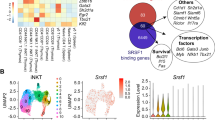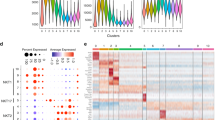Abstract
microRNAs (miRNAs) are small noncoding RNAs that mediate RNA interference to suppress protein expression at the translational level. Accumulated evidence indicates that miRNAs play critical roles in various biological processes and disease development, including autoimmune diseases. Invariant natural killer T (iNKT) cells are an unusual CD1d-restricted subset of thymus-derived T cells that are potent regulators of diverse immune responses. Our previous studies with the mouse model of bone marrow-specific Dicer deletion suggest the involvement of Dicer-dependent miRNAs in the development and function of iNKT cells. In the present study, to further dissect the functional levels of Dicer-dependent miRNAs in regulating iNKT cell development, we generated a mouse model with the Dicer deletion in the thymus. Our data indicate that lack of miRNAs following the deletion of Dicer in the thymus severely interrupted the development and maturation of iNKT cells in the thymus and significantly decreased the number of iNKT cells in the peripheral immune organs. miRNA-deficient peripheral iNKT cells display profound defects in activation and cytokine production upon α-galactosylceramide (α-GalCer) stimulation. Our results demonstrate a critical role of the miRNA-dependent pathway in the thymus in the regulation of iNKT cell development and function.
This is a preview of subscription content, access via your institution
Access options
Subscribe to this journal
Receive 12 digital issues and online access to articles
$119.00 per year
only $9.92 per issue
Buy this article
- Purchase on Springer Link
- Instant access to full article PDF
Prices may be subject to local taxes which are calculated during checkout




Similar content being viewed by others
References
Sharif S, Arreaza GA, Zucker P, Mi QS, Sondhi J, Naidenko OV et al. Activation of natural killer T cells by alpha-galactosylceramide treatment prevents the onset and recurrence of autoimmune Type 1 diabetes. Nat Med 2001; 7: 1057–1062.
Miyake S, Yamamura T . NKT cells and autoimmune diseases: unraveling the complexity. Curr Top Microbiol Immunol 2007; 314: 251–267.
Godfrey DI, Berzins SP . Control points in NKT-cell development. Nat Rev Immunol 2007; 7: 505–518.
Van KL . NKT cells: T lymphocytes with innate effector functions. Curr Opin Immunol 2007; 19: 354–364.
Mi QS, Meagher C, Delovitch TL . CD1d-restricted NKT regulatory cells: functional genomic analyses provide new insights into the mechanisms of protection against Type 1 diabetes. Novartis Found Symp 2003; 252: 146–160.
Mi QS, Ly D, Zucker P, McGarry M, Delovitch TL . Interleukin-4 but not interleukin-10 protects against spontaneous and recurrent Type 1 diabetes by activated CD1d-restricted invariant natural killer T-cells. Diabetes 2004; 53: 1303–1310.
Kronenberg M, Engel I . On the road: progress in finding the unique pathway of invariant NKT cell differentiation. Curr Opin Immunol 2007; 19: 186–193.
Kronenberg M, Gapin L . Natural killer T cells: know thyself. Proc Natl Acad Sci USA 2007; 104: 5713–5714.
Tupin E, Kinjo Y, Kronenberg M . The unique role of natural killer T cells in the response to microorganisms. Nat Rev Microbiol 2007; 5: 405–417.
Bendelac A, Savage PB, Teyton L . The biology of NKT cells. Annu Rev Immunol 2007; 25: 297–336.
Borowski C, Bendelac A . Signaling for NKT cell development: the SAP–FynT connection. J Exp Med 2005; 201: 833–836.
Savage AK, Constantinides MG, Han J, Picard D, Martin E, Li B et al. The transcription factor PLZF directs the effector program of the NKT cell lineage. Immunity 2008; 29: 391–403.
Zhou L, Seo KH, Wong HK, Mi QS . MicroRNAs and immune regulatory T cells. Int Immunopharmacol 2009; 9: 524–527.
Bartel DP . MicroRNAs: genomics, biogenesis, mechanism, and function. Cell 2004; 116: 281–297.
Chen CZ, Li L, Lodish HF, Bartel DP . MicroRNAs modulate hematopoietic lineage differentiation. Science 2004; 303: 83–86.
Cobb BS, Nesterova TB, Thompson E, Hertweck A, O'Connor E, Godwin J et al. T cell lineage choice and differentiation in the absence of the RNase III enzyme Dicer. J Exp Med 2005; 201: 1367–1373.
Muljo SA, Ansel KM, Kanellopoulou C, Livingston DM, Rao R, Rajewsky K . Aberrant T cell differentiation in the absence of Dicer. J Exp Med 2005; 202: 261–269.
Bernstein E, Kim SY, Carmell MA, Murchison EP, Alcorn H, Li MZ et al. Dicer is essential for mouse development. Nat Genet 2003; 35: 215–217.
Suarez Y, Fernández-Hernando C, Yu J, Gerber SA, Harrison KD, Pober JS et al. Dicer-dependent endothelial microRNAs are necessary for postnatal angiogenesis. Proc Natl Acad Sci USA 2008; 105: 14082–14087.
Koralov SB, Muljo SA, Galler GR, Krek A, Chakraborty T, Kanellopoulou C et al. Dicer ablation affects antibody diversity and cell survival in the B lymphocyte lineage. Cell 2008; 132: 860–874.
Mizoguchi F, Izu Y, Hayata T, Hemmi H, Nakashima K, Nakamura T et al. Osteoclast-specific Dicer gene deficiency suppresses osteoclastic bone resorption. J Cell Biochem 2009; 109: 866–875.
Cobb BS, Nesterova TB, Thompson E, Hertweck A, O'Connor E, Godwin J et al. A role for Dicer in immune regulation. J Exp Med 2006; 203: 2519–2527.
Liston A, Lu LF, O'Carroll D, Tarakhovsky A, Rudensky AY . Dicer-dependent microRNA pathway safeguards regulatory T cell function. J Exp Med 2008; 205: 1993–2004.
Zhou X, Jeker LT, Fife BT, Zhu S, Anderson MS, McManus MT et al. Selective miRNA disruption in T reg cells leads to uncontrolled autoimmunity. J Exp Med 2008; 205: 1983–1991.
Zhou L, Seo KH, He HZ, Pacholczyk R, Meng DM, Li CG et al. Tie2cre-induced inactivation of the miRNA-processing enzyme Dicer disrupts invariant NKT cell development. Proc Natl Acad Sci USA 2009; 106: 10266–10271.
Harfe BD, McManus MT, Mansfield JH, Hornstein E, Tabin CJ . The RNaseIII enzyme Dicer is required for morphogenesis but not patterning of the vertebrate limb. Proc Natl Acad Sci USA 2005; 102: 10898–10903.
Fedeli M, Napolitano A, Wong MP, Marcais A, de Lalla C, Colucci F et al. Dicer-dependent microRNA pathway controls invariant NKT cell development. J Immunol 2009; 183: 2506–2512.
Gapin L, Matsuda JL, Surh CD, Kronenberg M . NKT cells derive from double-positive thymocytes that are positively selected by CD1d. Nat Immunol 2001; 2: 971–978.
Benlagha K, Wei DG, Veiga J, Teyton L, Bendelac A . Characterization of the early stages of thymic NKT cell development. J Exp Med 2005; 202: 485–492.
Kim PJ, Pai SY, Brigl M, Besra GS, Gumperz J, Ho IC . GATA-3 regulates the development and function of invariant NKT cells. J Immunol 2006; 177: 6650–6659.
Acknowledgements
We thank M. McManus for Dicer-loxP mice, R. Qi for assistance with artwork and the NIH Tetramer Facility for CD1d tetramer. This work was support by grants from Juvenile Diabetes Research Foundation International (1-2005-1039, 5-2006-688 and 5-2006-918) and American Diabetes Association (7-05-JF-30).
Author information
Authors and Affiliations
Corresponding authors
Rights and permissions
About this article
Cite this article
Seo, KH., Zhou, L., Meng, D. et al. Loss of microRNAs in thymus perturbs invariant NKT cell development and function. Cell Mol Immunol 7, 447–453 (2010). https://doi.org/10.1038/cmi.2010.49
Received:
Revised:
Accepted:
Published:
Issue Date:
DOI: https://doi.org/10.1038/cmi.2010.49
Keywords
This article is cited by
-
microRNA dynamic expression regulates invariant NKT cells
Cellular and Molecular Life Sciences (2021)
-
The abundance of a transfer RNA-derived RNA fragment small RNA subpopulation is enriched in cauda spermatozoa
ExRNA (2020)
-
Let-7 microRNAs target the lineage-specific transcription factor PLZF to regulate terminal NKT cell differentiation and effector function
Nature Immunology (2015)
-
The role of microRNAs in lymphopoiesis
International Journal of Hematology (2014)
-
MicroRNAs are key regulators controlling iNKT and regulatory T-cell development and function
Cellular & Molecular Immunology (2011)



